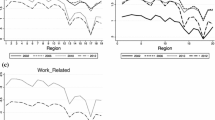Abstract.
We investigate the effects of demographics, household expenditure and female employment on the allocation of household expenditure to consumer goods. For this purpose we estimate an Almost Ideal Demand System based on Dutch micro data. We find that interactions between household expenditure and demographics are of significant importance in explaining the allocation to consumer goods. As a consequence, consumer goods such as housing and clothing change with demographic characteristics from luxuries to necessities. Furthermore, this implies that budget and price-elasticities cannot be consistently estimated from aggregated data and that equivalence scales are not identified from budget survey data alone. We reject weak separability of consumer goods from female employment. A couple with an employed spouse has a smaller budget share for housing and personal care and a larger budget share for education, recreation and transport and clothing compared to a couple with a non-employed spouse.
Similar content being viewed by others
Author information
Authors and Affiliations
Additional information
Received: 12 September 1997/Accepted: 27 February 1998
Rights and permissions
About this article
Cite this article
Kalwij, A., Alessie, R. & Fontein, P. Household commodity demand and demographics in the Netherlands: A microeconometric analysis. J Popul Econ 11, 551–577 (1998). https://doi.org/10.1007/s001480050084
Issue Date:
DOI: https://doi.org/10.1007/s001480050084



